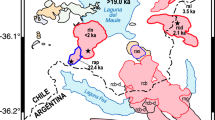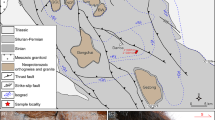Abstract
Olivine in spinel peridotite xenoliths from the Bismarck Archipelago northeast of Papua New Guinea, which were transported to the surface by Quaternary basalts, shows spinel inclusions up to 25 μm long and 200 nm wide. These inclusions mainly occur as inhomogeneously distributed needles and subordinately as octahedral grains in olivine of veined metasomatic peridotites as well as peridotites without obvious metasomatism. The needles very often occur in swarms with irregular spacing in between them. Similar spinel inclusions in olivine have only previously been reported from ultramafites of meteoritic origin. Composition and orientation of the spinel inclusions were determined by transmission electron microscopy (TEM) and analytical electron microscopy (AEM). Both the needles and the grains display a uniform crystallographic orientation in the host olivine with [001]O1//[1¯10]Spl and (100)Ol// (111)Spl. The needles eare elongated parallel [010] in olivine, which is the same in all olivine grains. As these needles have no relation to the metasomatic sections in the peridotite, it is concluded that they are primary features of the rock. Although the composition of the spinel needles is often very similar to the large chromian spinel octahedra in the matrix, the small octahedral spinel inclusions in olivine are in part Mg-rich aluminous spinel and sometimes almost pure magnetite. The spinel needles are suggested to have formed by exsolution processes during cooling of Al- and Cr-rich, high-temperature olivine during the initial formation of the lithospheric mantle at the mid-ocean ridge. The Al-rich spinel octahedra probably formed by the breakdown of an Al-rich phase such as phlogopite or by metasomatism, whereas the magnetite was generated by oxidizing fluids. These oxidizing fluids may either have been set free by dehydration of the underlying, subducted plate or by the Quaternary magmatism responsible for the transport of the xenoliths to the seafloor.
Similar content being viewed by others
Author information
Authors and Affiliations
Additional information
Received: 25 May 2000 / Accepted: 12 July 2000
Rights and permissions
About this article
Cite this article
Franz, L., Wirth, R. Spinel inclusions in olivine of peridotite xenoliths from TUBAF seamount (Bismarck Archipelago/Papua New Guinea): evidence for the thermal and tectonic evolution of the oceanic lithosphere. Contrib Mineral Petrol 140, 283–295 (2000). https://doi.org/10.1007/s004100000188
Published:
Issue Date:
DOI: https://doi.org/10.1007/s004100000188




